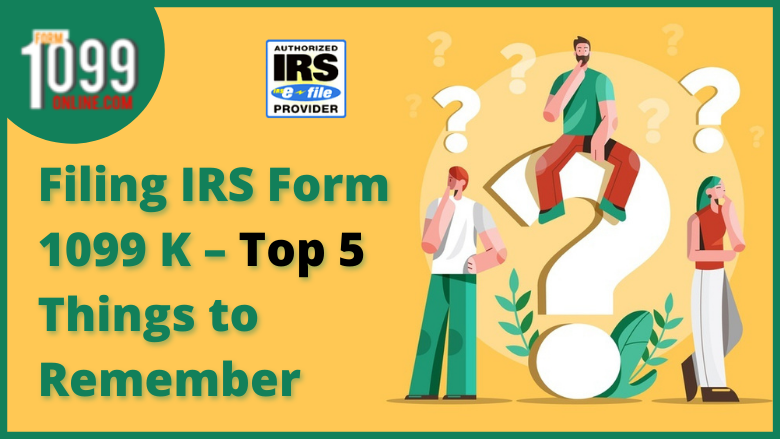Did you pay contractors using payment cards or third-party networks? Then you need to file Form 1099 K and report the transaction made. Before filing make sure to check whether you need to issue a 1099 or not.
Getting confused? Don’t worry! We will provide you with five important things to remember when filing IRS Form 1099 K. So, you can identify who is a contractor and who is an employee. Besides, you can also check whether the payments made meet the reporting rules of the form.

Identify 1099 individual
Firstly, before filing any 1099 information return to the IRS every business owner must identify the individual whom they hire. By identifying the payment made to the individual, you can determine whether to file Form 1099 or not. For contractors, we must file a 1099 Form and for employees, we must file a W-2 Form. if you misclassify an employee as a contractor, the IRS may treat it as incorrect filing. Moreover, you will end up with 1099 rejections. So, plan before issuing 1099 information returns. If you’re business meet the following criteria, then you need to file a 1099 Form to the individual:
- The individual who you hired performs services related to your business but not as an employee.
- Services performed by the contractor are on a course of business or trade but not for personal purposes.
- If you don’t have control over work performed by the individual.
- The payment made to the non-employee exceeds $600 in a tax period.
Check Form 1099 K reporting rules
According to the IRS, This Form came into existence as per the 2008 HAT Act to ensure that online retailers are reporting sales for tax purposes or not. The IRS requires credit card organizations like Visa, Mastercard, etc to report the payment card transactions they process on behalf of retailers. Finally, you’ll end up filing 1099 K when you made payments using third-party networks to an individual. Following are the reporting rules for IRS Form 1099 K:
- Payments made to the individual involve payment cards like credit, debit, or third-party processors like PayPal, Amazon, etc.
- The volume of sales using third-party processors exceeds $20,000.
- Individual payment card transactions volume exceeds 200 in a tax year.
- If the sales volume is over $600 in limited instances in a calendar year.
Collect W-9 Forms from 1099 contractors
After deciding whether the individual is a 1099 contractor or W-2 employee, collect W-9 Forms from the contractor. W-9 Form provides payee information like name, address, Taxpayer Identification Number. With which 1099 information returns can be filed error-freely. Furthermore, businesses can avoid backup withholding taxes from the payee. Hence, the IRS every business individual to collect the W-9 Form before making the first payment to the contractor. Moreover, with the help of the W-9 Form businesses can identify the type of payee. A payee can be an individual, business, partnership, estate, corporation, LLC, etc. Furthermore, payees are responsible to mention their type with which the payer can know whether to issue a 1099 or not. However, a corporation like C or S doesn’t receive 1099. This means payments made to corporations are not reported on the information return form.
Report the amount on 1099 K Form
Finally, report the amount in the correct box of Form 1099 K. IRS 1099 K is comprised of 8 boxes. Enter the required information in the appropriate box:
Box 1a
Enter the gross amount paid to the individual through a payment card or third-party networks in “Box 1a”.
Box 1b
Provide the transactions in which cards are not involved in this box.
Box 2
Provide the Merchant Category Code in box 2.
Box 3
Mention the number of payment transactions made through third-party networks.
Box 4
Enter the amount of federal taxes withheld in box 4 of the form.
Box 5a to 5l
Enter the total reportable transactions made each month in the boxes 5a to 5l of the form.
Box 6 to 8
If the tax amount exceeds your state tax amount, then provide the state information like state name, tax amount, state identification number.
Check Form 1099 K deadline
After gathering the required information, the final step is to transmit 1099 returns to the IRS before the deadline. Given below are the keys dates to file Form 1099 K:
- Form 1099 K recipient copy is due by January 31st every tax year. So, start filing information returns at the beginning of the new tax year.
- 1099 K Form due to the IRS through the paper file by February 28th every year and through e-file by March 31st annually.
Ready to file Form 1099 K? Which method you would choose e-file or paper file? The IRS recommends the taxpayer choose e-filing for transmitting a single tax return. Form 1099 Online is the best among all the IRS-certified e-file providers. Start filing multiple tax returns with a single e-file account.
